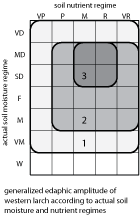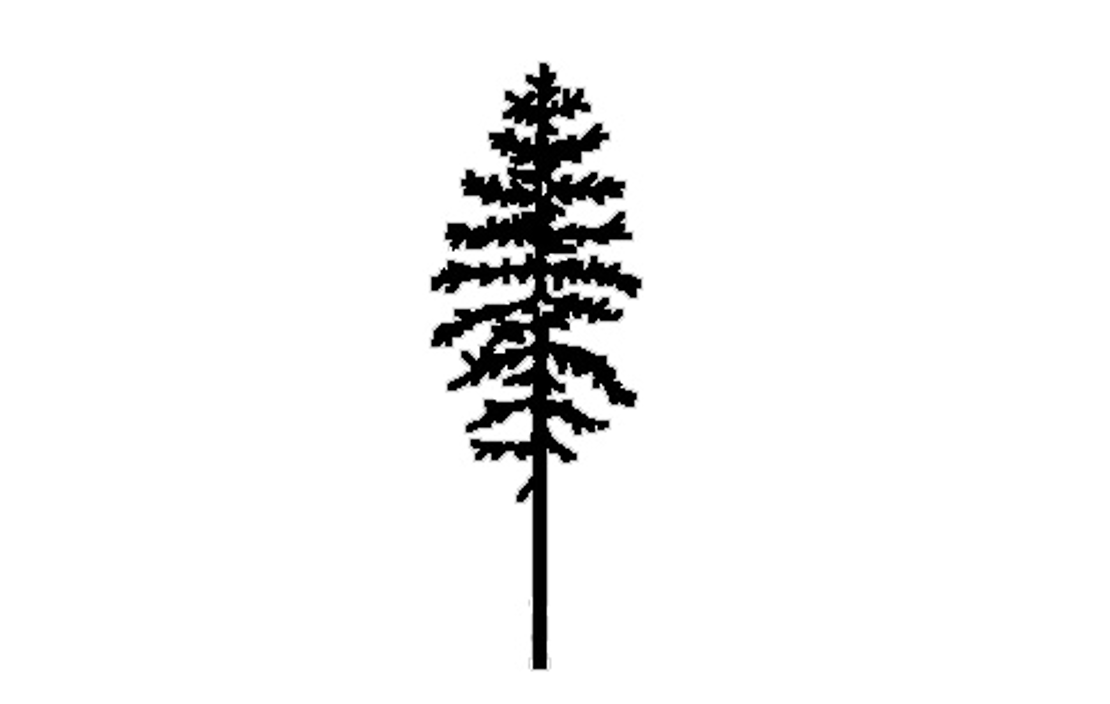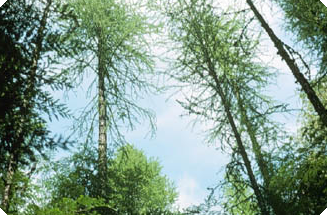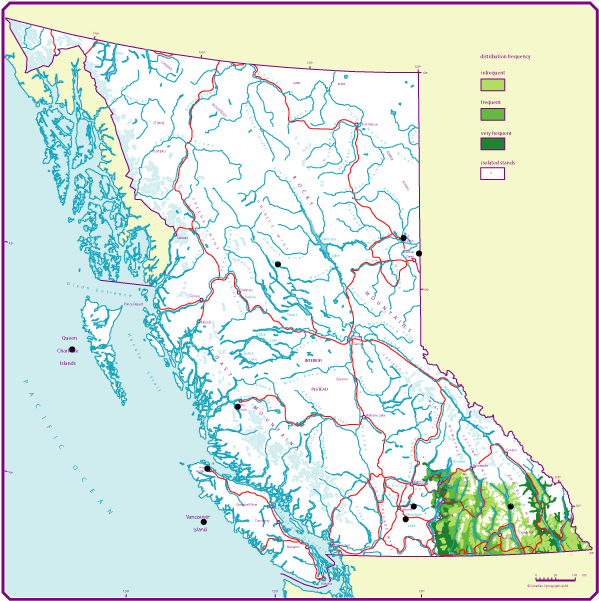Western larch
On this page
- Geographic range and ecological amplitudes
- Tolerances and damaging agents
- Silvical characteristics
- Genetics and notes
Geographic range and ecological amplitudes
Description
Western larch is a medium - to large-sized (occasionally >60 m tall), deciduous conifer, with a branch-free stem over much of its length; short, narrow, pyramidal crown and horizontal branches; reddish-brown, deeply furrowed bark with flaky ridges. Western larch is the world’s largest and most important timber species of this genus. It is an aesthetically attractive species, which is used for lumber, fine veneer, poles, ties, mine timber, and pulp.
Geographic range
Geographic element:
Western North American/Cordilleran
Distribution in Western North America:
central in the Cordilleran region
Ecological amplitudes
Climatic amplitude:
(cool semiarid) - cool temperate - (subalpine boreal)
Orographic amplitude:
montane – (subalpine)
Occurrence in biogeoclimatic zones:
(lower southern ESSF), southern MS, (PP), southern IDF, southern drier ICH
Edaphic amplitude

Range of soil moisture regimes:
(very dry) - moderately dry - slightly dry - fresh – moist - (very moist)
Range of soil nutrient regimes:
(very poor) - poor - medium - rich - very rich
In comparison with interior common douglas, western larch is infrequent on moist and very moist sites on which common douglas attains the most productive growth. It appears that western larch is more abundant and vigorous on calcium- and magnesium-rich soils than on acidic soils.
Tolerances and damaging agents
Root system characteristics
Western larch develops a deep and extensive root system. Fibrous roots under young larch stands extend up to 100 cm in depth. Wind-fallen mature larch trees have their roots usually infected by root rots. Roots of western larch are associated with both ecto- and endo-mycorrhizae.
| Tolerance to | Tolerance class | Comments |
|---|---|---|
| Low light | L | A shade-intolerant and exposure-requiring species, except in the PP zone where it appears to be moderately shade-tolerant. |
| Frost | M | |
| Heat | M | Infrequent in the lower PP |
| Water deficit | M | Infrequent on very dry sites. |
| Water surplus | L | Absent on waterlogged sites. |
| Nutrient (mainly N) deficiency | M | Tolerates acid substrates. |
| Damaging agent | Resistance class | Comments |
|---|---|---|
| Snow | H | Due to open crown and deciduous nature |
| Wind | H | Deeply rooted with an open crown |
| Risk class | ||
|---|---|---|
| Fire | H | Risk is high but resistance to ground fires is also high; resistance increases with age. |
| Insect | M | Larch casebearer, western spruce budworm, larch needle blight. |
| Fungi | L | Not a major concern; brown trunk rot, red ring rot. |
| Other agents | M | Dwarf mistletoe (Arceuthobium laricis (Piper) St. John). |
Associated tree species and successional role
In southeastern British Columbia, western larch may grow in pure stands but more frequently, it grows in mixed-species stands. Old-growth western larch stands are rare. It is present in early, mid-, and late stages of fire-driven, secondary succession.
| Associated tree species |
Occurance class | Major area of occurance |
|---|---|---|
| Lodgepole pine | H | Throughout southern B.C. |
| Common douglas | M | Throughout southeastern B.C. |
| Western redcedar | M | Southern ICH |
| Subalpine fir | L | Southern B.C. |
| Engelmann spruce | L | Lower ESSF |
| Ponderosa pine | L | Upper PP and lower IDF |
| Western hemlock | L | Southern ICH |
Genetics and notes
Genetics
Some population differences were detected but races, varieties, or subspecies of western larch are not known.
Notes
Western larch forests are valued for their multiple resource values. Thus, the presence of the species in pure as well as mixed-species stands should be maintained or even increased where multiple resource use is the major management objective. More detailed silvics information is given by:
Schmidt, W.C. and R.C. Shearer. 1990. Larix occidentalis. Pp. 160-172 in R.M. Burns and B.H. Honkala (technical coordinators) Silvics of North America, Vol. 1. Agri. Handbook 654, USDA For. Serv., Washington, D.C.
Schmidt, W.C. and K.J. McDonald. (compilers) 1992. Ecology and management of Larix forests. GTR-INT-319, USDA For. Serv., Intermountain Research Station, Ogden, Utah.
Schmidt, W.C. and K. J. McDonald (compilers) 1995. Ecology and management of Larix forests: a look ahead. Proceedings of an International Symposium, Whitefish, Montana, October, 5-9, 1992. GTR-INT-319, USDA For. Serv., Intermountain Research Station, Ogden, Utah.
Other information:

This is the general shape and outline of the western larch.

A two-storied western larch stand near Cranbrook, typical of the wetter portion of the IDF zone and the drier portion of the ICH zone. These climatic regions support the most productive growth in larch.

